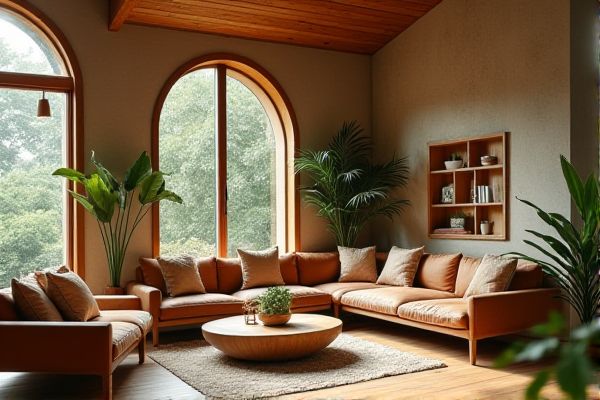
Butterfly houses provide shelter and breeding grounds specifically designed for butterflies, promoting their lifecycle and helping sustain their populations, while bee hotels offer habitat for solitary bees to nest and thrive, supporting pollination in your garden. Explore the rest of the article to discover which structure best suits your outdoor space and benefits your local ecosystem.
Table of Comparison
| Feature | Butterfly House | Bee Hotel |
|---|---|---|
| Purpose | Provide shelter and breeding habitat for butterflies | Offer nesting sites for solitary bees |
| Primary Inhabitants | Butterflies (e.g., monarch, swallowtail) | Solitary bees (e.g., mason bees, leafcutter bees) |
| Design | Enclosed, ventilated structure with nectar plants | Wooden blocks/tubes with holes for nesting |
| Materials | Wood, mesh, plants | Natural wood, bamboo, drilled blocks |
| Placement | Sunny, sheltered garden spots with flowers | Sunny, dry locations, protected from rain |
| Maintenance | Regularly clean to prevent mold, provide food plants | Clean yearly, remove debris, prevent parasites |
| Benefit | Supports butterfly populations and pollination | Enhances solitary bee survival and pollination |
Introduction: Understanding Pollinator Habitats
Butterfly houses provide shelter and breeding spaces specifically designed for butterflies, enhancing their habitat by mimicking natural environments with slatted wood structures and bright colors. Bee hotels cater to solitary bees by offering small tubular cavities or hollow stems for nesting, crucial for supporting pollinator populations and biodiversity. Both structures play vital roles in sustaining pollinator habitats, promoting local ecosystems and agriculture through increased pollination activity.
What Is a Butterfly House?
A butterfly house is a specially designed enclosure that provides shelter and a safe environment for butterflies to rest and lay eggs. It mimics natural habitats with small openings and places for butterflies to perch, often featuring nectar-rich plants to attract and support adult butterflies. Unlike bee hotels, which focus on solitary bee nesting, butterfly houses prioritize protection and habitat for butterflies throughout their lifecycle stages.
What Is a Bee Hotel?
A bee hotel is a man-made structure designed to provide solitary bees with safe nesting sites, crucial for pollination and biodiversity. Unlike butterfly houses that cater to butterflies' shelter and breeding needs, bee hotels often consist of hollow tubes or drilled wood blocks where solitary bees like mason and leafcutter bees reproduce. Installing bee hotels supports native bee populations, enhancing garden health and crop pollination.
Key Differences Between Butterfly Houses and Bee Hotels
Butterfly houses primarily provide sheltered environments with open, ventilated spaces suited for butterflies to rest and roost, whereas bee hotels offer numerous small tubular chambers or holes designed to accommodate solitary bees for nesting and reproduction. Unlike butterfly houses, which are more decorative and attract passive butterfly visitors, bee hotels directly support pollinator populations by facilitating breeding habitats for species like mason and leafcutter bees. The materials used also differ: butterfly houses often feature mesh or wooden frames to allow airflow, while bee hotels incorporate bundles of hollow reeds or drilled wood blocks to mimic natural nesting sites.
Habitat Requirements: Butterflies vs. Bees
Butterfly houses require ample sunlight, open spaces, and access to nectar-rich flowers to support adult butterflies, while bees prefer nesting sites with suitable cavities or tunnels often found in wood or soil. Butterflies thrive in habitats with host plants for caterpillars and warmer temperatures, whereas solitary bees need undisturbed soil or hollow stems to lay eggs. Creating environments that cater to these distinct habitat requirements increases the survival rates for both pollinators.
Benefits of Installing a Butterfly House
Installing a butterfly house supports local pollinator populations by providing safe shelter for butterflies during their life cycle stages, promoting biodiversity in gardens and natural spaces. These structures help attract various butterfly species, aiding in the pollination of flowering plants, which enhances plant health and fruit production. Unlike bee hotels that primarily cater to solitary bees, butterfly houses specifically cater to butterflies, enriching the ecosystem by fostering a balanced pollinator environment.
Benefits of Installing a Bee Hotel
Installing a bee hotel supports native solitary bee populations, which are vital pollinators for gardens and agricultural crops, enhancing biodiversity and boosting local ecosystems. These structures provide essential nesting habitats that are increasingly scarce due to urbanization and habitat loss, ensuring bees have safe places to reproduce. Bee hotels also improve crop yields by promoting effective pollination and raise public awareness about the importance of conserving pollinator species.
Common Design Features and Materials
Butterfly houses and bee hotels share common design features such as multiple compartments or tubes to provide shelter and breeding spaces, often using natural materials like wood, bamboo, and hollow stems. Both structures emphasize ventilation and protection from predators and weather, incorporating sloped roofs and small entrance holes to maintain an ideal microenvironment for insects. Sustainable, untreated wood is frequently used in both to ensure safety and longevity, supporting diverse pollinator populations effectively.
Tips for Choosing the Right Pollinator Shelter
When selecting the right pollinator shelter, consider the specific needs of the local pollinators in your area, such as butterflies or solitary bees, as both require different habitat structures. Butterfly houses should have spacious chambers to accommodate their size and prevent overheating, while bee hotels need varied tube diameters and protection from moisture to support solitary bee nesting. Your choice impacts pollination effectiveness, so prioritize quality materials and placement in a sunny, sheltered spot to attract and protect these beneficial insects.
Conclusion: Which Shelter Suits Your Garden Best?
A butterfly house offers a decorative haven enhancing pollination and visual appeal, while a bee hotel primarily supports solitary bees by providing essential nesting sites that boost local biodiversity. Your garden's needs determine the best fit, with butterfly houses benefiting butterfly populations and bee hotels fostering crucial pollinators that improve plant health and productivity. Choosing between them depends on whether your goal is to attract butterflies for aesthetic enjoyment or to support solitary bee populations for ecological balance.
 homyna.com
homyna.com